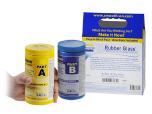Rubber Glass ™ Platinum Cure Silicone
Buy Smooth-On at FormX
Smooth-On is one of the worlds leading manufaturers 3D modeling materials such as mold-making, casting and special effects materials but also industrial casting resins, adhesives and equipment. FormX is main distributor of Smooth-On products in Europe.
Water-Clear Silicone Rubber Perfect for making Flexible Glass & Ice Effects. Rubber Glass ™ can be used to create a variety of special effects (i.e. simulated broken glass where human contact is required) and model effects (i.e. simulated ice or water). It can also be used for electronic encapsulation applications.Rubber Glass ™ can be easily broken or crumbled into pieces that look exactly like broken glass, ice or diamonds. Vacuum degassing material prior to pouring will produce bubble free castings.
Measuring and mixing - Materials should be stored and used in a warm environment 23°C . This product has a limited shelf life and should be use as soon as possible. Mixing containers and stirring sticks should be made of plastic and must be clean and dry. Wear safety glasses, long sleeves and rubber gloves to minimize contamination risk.
Dispense One Parts A and One Part B by weight or volume into mixing container. Mix thoroughly for at least three minutes, making absolutely sure that you scrape the sides and bottom of your container several times.
Do not whip or agitate material as this may cause air bubbles. If completely bubble free castings are required, vacuum degassing material prior to pouring will eliminate all bubbles.
Pouring - Pour mixture into a plastic container or mold (ice cube trays or plastic cups made of polyethylene work well). If pouring into or over other surfaces, be aware that cure inhibition is possible (see section below – “Cure Inhibition”). If casting into silicone molds, a release agent (Ease Release® 200 available from Smooth-On) is required.
Curing - Let cure overnight at room temperature 23°C. Colder temperatures will slow the curing process. Material castings thicker than 5 cm may take longer to cure. Material is cloudy when first mixed but clears during cure.
Cure Inhibition - If compatibility between the rubber and the surface that you are pouring rubber over is a concern, a small scale test is recommended. Materials found to cause cure inhibition include sulfur-based modeling clays and latex rubber. If pouring Rubber Glass® II over a model surface that you think might cause inhibition, apply a “barrier coat” of clear acrylic lacquer sprayed directly over all surfaces that will come in contact with the Rubber Glass® II is usually effective.
Adhesion- Rubber Glass® II may stick to some surfaces such as glass. A coating of Ease Release® 200 will facilitate release from any surface.
Material Performance - Once material has fully cured it can be removed from the container or mold. Cured Rubber Glass® II is now ready to be displayed as is or broken/crumbled for your specific application.
Because no two applications are quite the same, a small test application to determine suitability for your project is recommended if performance of this material is in question.

